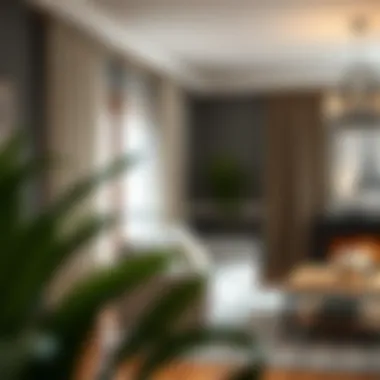Choosing the Right Length for Curtain Rods


Intro
Selecting the right curtain rod length serves not only a functional purpose but also plays a crucial role in enhancing the aesthetic appeal of a room. The right choice can transform a simple window treatment into a sophisticated focal point, tying together the overall decor of a space. Taking measurements accurately, understanding various room designs, and knowing what materials and styles work best can be overwhelming for homeowners and designers alike.
This guide explores the nuances of choosing curtain rods tailored to room dimensions and decorative styles. It will delve into common pitfalls and provide recommendations to ensure a cohesive and stylish look in your home. Let's unravel this thread, one at a time, to understand how to elevate a room's ambiance through thoughtful selection of curtain rod lengths.
Furniture Design Styles
When it comes to selecting curtain rods, understanding different furniture design styles is essential. These styles inform the decision-making process, ensuring each element harmonizes seamlessly within the space.
Overview of Popular Styles
- Modern: Characterized by clean lines and minimalistic designs. Curtain rods in matte finishes or sleek metal are ideal here, offering a sophisticated touch without overwhelming the space.
- Rustic: Emphasizing natural materials, a rustic style benefits from wooden rods or those with a wrought-iron finish. They complement earthy tones and create a warm, inviting ambiance.
- Traditional: This style often features ornate details and luxurious finishes. Curtain rods with decorative finials and rich, classical colors can elevate the grandeur of a traditionally styled room.
- Bohemian: An eclectic mix of patterns and textures defines this style. Flexible curtain rods allow for playful draping, and materials can vary significantly from vintage wood to colorful metal.
How to Mix and Match Styles
Mixing styles can create a unique interior ambiance. However, striking the right balance is key. For example, pairing a modern rod with traditional drapes might work if the color palette remains cohesive.
- Consistency in Color: Select curtain rods that align with the color scheme of the room to unify diverse styles.
- Texture Play: If you're blending rustic with modern, consider how different textures can complement each other. A rich wood rod against a crisp white curtain can create a beautiful contrast.
- Scale Matters: It's vital that the scale of the curtain rod fits the window size and style. A heavy wooden rod may not suit a delicate, airy room, just as a slim metal rod might look out of place in a richly decorated space.
"A well-coordinated space hinges on the thoughtful interplay of style, color, and texture across all room elements."
Practical Tips for Homeowners
Making the right choices when purchasing curtain rods involves careful consideration. From functionality to aesthetics, there are essential guidelines every homeowner should follow.
Essential Buying Tips
- Measure Accurate Lengths: Measure from the outside of the window frame to ensure you select a rod that allows for proper draping and light blocking.
- Rod Material: Consider the room's style and function. Metal rods are durable and contemporary, while wooden options offer warmth and organic appeal.
- Weight Compatibility: Ensure the rod can support the weight of the curtains chosen. Heavy fabrics like velvet require sturdier options.
Maintenance and Care Guidelines
Taking care of your curtain rods ensures longevity and sustained aesthetic appeal.
- Dust Regularly: Wipe down metal rods with a soft cloth, as dust can dull their shine.
- Inspect Brackets: Regularly check the brackets and supporting hardware to ensure they are secure and functioning properly. Loose fixtures can lead to sagging or misalignment.
- Cleaning: If your rods are wooden, use a damp cloth and ensure no moisture seeps into the material, while metal rods may benefit from a gentle polish to maintain their luster.
Ultimately, the successful integration of curtain rods into your home decor hinges on a careful interplay of length, material, and style. With the right information and consideration, achieving an elevated interior that reflects your personal style becomes not an aspiration but a reality.
Understanding Curtain Rod Length
Choosing the right curtain rod length is a crucial part of interior design that can greatly influence the look and feel of a room. This section dives into the importance of understanding curtain rod length, covering factors like measurements, types of windows, and how these elements impact your decorative choices.
Curtains do more than just offer privacy or block light; they can affect the overall aesthetic of a room. The length of your curtain rod plays a significant role in achieving the desired effect, whether it's making a small room feel larger or giving a high ceiling a more intimate atmosphere. Therefore, it’s essential to approach this topic with a careful eye and a discerning mindset.
Importance of Measuring Room Length
Accurate measurement of your room length is a fundamental step in the process of selecting the perfect curtain rod. The phrase "measure twice, cut once" rings especially true in this context. If your measurements are off, the entire window treatment may appear awkward or out of place.
- What to Measure? You should focus on the width of the window as well as the height where the rod will be mounted. An effective approach is to extend the rod beyond the window frame, allowing light to enter from the sides and presenting a more spacious appearance.
- Why it Matters? Incorrect measurements can lead to either excessive material that makes a window look dwarfed or insufficient length that leaves the window bare. These oversights not only hinder functionality but also clash with visual appeal. Homeowners should ensure they leave at least a few inches on either side of the window frame.
"Effective measurements are the foundation upon which a stylish room is built."
Ultimately, measuring your room length correctly minimizes the risk of mistakes during installation and secures an elegant look.
Types of Windows and Their Dimensions
Just like every thumbprint is unique, so too is every window, and they come in various shapes and sizes. Understanding these different types can profoundly change how you approach your curtain rod selection.
- Standard Windows: Most homes feature double-hung or casement windows. These can typically accommodate standard rod lengths, but be cautious with their height above the floor. Also, consider additional space above for the actual rod and rings.
- Bay and Bow Windows: These require a bit more finesse. You often need custom lengths or curved rods to match their unique angles, ensuring the curtains hang properly without bunching.
- Sliding Glass Doors: These present their own set of challenges; longer rods allow for ample curtain movement when opening or closing. Here, again, leaving some space on the sides helps when they're pulled back.
- Arched Windows: Not all dramatic looks require complicated curtain lengths, but where rounded tops are involved, special rods are needed to curtail gaps.
Each type of window has its own requirements, making it vital to consider these variations in your design strategy. A keen understanding of your windows not only guarantees proper fit but also empowers you to enhance the elegance of your interior design.
The Aesthetic Role of Curtain Rods


Curtain rods serve more than just function; they’re a key element in the overall aesthetic of a room. A well-chosen rod not only holds your curtains in place but also enhances the style and vibe of your space. From elegant to contemporary, rods come in various designs that can align with or contrast your color palette, creating a thematic harmony.
Curtain rods can change the perception of a room's size and proportions, making it crucial to consider their aesthetic role. For designers and homeowners alike, understanding how these rods contribute to visual appeal helps in crafting spaces that are both functional and stylish.
Enhancing Room Proportions
One of the stark realities in interior design is the significance of proportion. The right curtain rod can dramatically affect how spacious or cozy a room feels. For example, a long, sleek rod can draw the eye upward, giving an illusion of higher ceilings. On the other side, using a rod that is too short can visually compartmentalize the space, making it feel smaller and more cluttered.
Key Considerations for Room Proportions:
- Length and Width: Using a longer rod than necessary can make a window appear wider, thus enhancing the overall room feel.
- Placement: Hanging the rod closer to the ceiling creates verticality, adding a sense of expansiveness.
- Curtain Style: Consider how the design of your curtains interacts with the rod. Floor-length curtains create trustworthiness with the room’s height, while shorter curtains might overstretch the area in a way that compresses the feel.
Creating Verticality in Design
Vertical lines can make a profound difference in the atmosphere of a room. When selecting curtain rods, opting for styles that boast height contributes significantly to verticality. Rods that rise high above the window frame can create the illusion of more light and, subsequently, a more airy environment.
Utilizing decorative rods that also emphasize vertical lines can enhance this effect. For example, designs that feature intricate detailing or geometric cuts often catch the eye in a way that draws it upward.
Moreover, the materials of the rods can play a part—metal rods tend to carry a more sleek, modern appeal, whereas wooden rods might convey warmth and classic charm.
"An effective design considers both height and width, utilizing rods to create a seamless transition between vertical and horizontal planes."
Ultimately, the aesthetic role of curtain rods is multifaceted. It goes beyond merely holding fabric; it involves creating a cohesive and well-balanced visual narrative in your space. Utilizing form and function harmoniously can elevate any room, making it feel intentional and thoughtfully designed.
Factors Influencing Rod Length
Choosing the right length for curtain rods goes beyond mere aesthetics; it intertwines with practical elements that can significantly affect both the functionality of your window treatments and the overall ambiance of a room. Understanding the factors that influence curtain rod length can transform a simple choice into a savvy decision, allowing designers, retailers, homeowners, decorators, and DIY enthusiasts to strike the right balance between style and purpose.
Ceiling Height Considerations
Ceiling height plays a crucial role in determining the appropriate length of curtain rods. In spaces with higher ceilings, opting for longer rods can create a sense of grandeur, giving the impression that the room is even more spacious. Installing the rod closer to the ceiling, rather than directly above the window, enhances this effect. A common recommendation is to position the rod approximately four to six inches above the window frame, or even closer to the ceiling, to draw the eyes upward.
On the flip side, in rooms with standard or lower ceilings, shorter rods might be more suitable. However, consider using a mounting strategy that maximizes height perception. In this case, extending the curtain rod beyond the window frame allows curtains to pool attractively on the floor while also contributing to a more elevated visual line.
Window Treatment Style Compatibility
The style of window treatments you choose greatly influences rod length. Different types of curtains or drapes, whether they're sheer, blackout, or heavy fabrics, require various lengths based on how you plan to hang them. For example, if you're installing a sheer curtain for a breezy, light feel, a shorter rod may suffice, depending on the fabric length.
On the other hand, if you're leaning towards a more dramatic effect with heavy draperies, a longer rod will not only offer better support but also allow for a more fluid opening and closing mechanism. Remember, the design of the curtain—whether it should fall straight down or pool at the bottom—will dictate how you measure. Pay attention to the specific requirements of your chosen curtain style, as they can dramatically alter the ideal rod length.
Proximity to Window Trim and Molding
When measuring for curtain rods, the proximity to window trim and molding is another vital consideration. The trim and molding around your windows can establish valuable guidelines for where to place the rod. If your window features ornate molding, it’s generally best to hang the rod at a height that visually aligns with the trim, avoiding any jarring dissonance in design.
In situations where the molding is particularly elaborate, you might want to consider a length that complements the trim elegantly while allowing sufficient coverage for the curtain to block light effectively. Taking a moment to measure from the top of the molding can greatly aid in making the right rod length decision, ensuring an intelligent design that flows smoothly.
"A well-chosen curtain rod achieves more than practical use; it becomes a defining element in your interior design."
In summation, the factors influencing rod length should not be taken lightly, as they can enhance functionality and beauty in any room. By carefully considering ceiling height, window treatment styles, and the relationship between curtain rods and window trim, one can make an informed choice that elevates the spirit of the space.
Measuring for Curtain Rods
Accurately measuring for curtain rods is not just a detail; it’s the very foundation that determines how well window treatments function while also influencing the room's aesthetic appeal. Getting this right can transform a space, while a simple miscalculation can lead to unsightly gaps or worse—curtains that don’t hang or function properly. Whether you’re a homeowner diving into a bit of DIY or a seasoned designer looking to maintain your edge, understanding the nuances of curtain rod measurements is essential.
Tools Needed for Accurate Measurement
To embark on this measurement journey, having the proper tools at your disposal is crucial. Skimping on the basics can lead to errors that are all too easy to avoid. Here’s a handy list of tools you need:
- Measuring Tape: A flexible measuring tape is your best friend here—it conforms to surfaces and gives you accurate readings even in tricky spots.
- Pencil or Non-permanent Marker: Use these to mark your measurements on the wall. Make sure it’s something that won’t leave a lasting mark.
- Level: Ensures that your bracket placements are straight, which helps the rod hang evenly.
- Step Ladder: For those higher ceilings, a sturdy ladder or step stool will make your life a lot easier.
Having these tools ready not only makes the process smoother but also helps ensure accuracy. Little things, like a flimsy tape measure, could lead to miscalculations—so choose wisely.
Step-by-Step Measurement Guide
Measuring for curtain rods seems straightforward, but there are specific steps that ensure comprehensive and correct results. Follow this guide:


- Identify the Placement: Decide if you want the rod above the window or flush with the top. Many designers opt for placing the rod higher to create an illusion of taller ceilings.
- Measure the Width: Start by measuring the window width.
- Determine the Height: Measure from the top of where you want the rod to sit down to where you want the curtains to end.
- Check for Obstacles: Consider any window trims, moldings, or other architectural features that might alter your measurements. This is essential—nothing worse than fitting a rod only to find it gets obstructed by a molding!
- Record Your Measurements: Write it all down as you go. It’s easy to forget numbers while deliberating over style choices. Note your width, height, and any other specifications.
- Double-check: Don’t rush this part. Taking the time to double-check your measurements can save you a headache later on.
- Extend the tape about six inches beyond the window frame on both sides. This helps in capturing light and provides a fuller look when the curtains are closed.
- Add this dimension to your total width measurement.
- For floor-length curtains, remember to add an inch or two to account for any floor puddling, if desired. This height is critical to how the whole setup integrates with your room.
Measuring may seem simple at first glance, but mastering it can make the difference between a polished finish and a lackluster result. Great designs begin with precise calculations, and managing the curtain rod length often sets the stage for the room's overall aesthetic.
"A measurement is only as good as the accuracy with which it is taken."
With this comprehensive approach, you're not only equipped to measure accurately but are also ready to choose the perfect curtain rods that suit your spaces. Remember, accuracy is the key to stylish and functional window treatments.
Choosing the Right Curtain Rod Length
Selecting the right curtain rod length is not merely a matter of personal preference; it plays a crucial role in how a room appears and functions. The right length allows curtains to hang beautifully, enhancing both style and practicality. It’s important to consider various elements involved in this decision, such as window size, ceiling height, and the overall aesthetic goal. A well-chosen rod can accentuate the natural lines of a room and help create a harmonious visual flow.
Standard Rod Lengths and Options
When it comes to standard curtain rod lengths, there's a variety of choices available. Most manufacturers offer rods in common sizes such as 28-48 inches for small windows, and 48-84 inches for larger openings. These lengths suit many typical windows found in homes and are widely accessible at home improvement stores and online.
However, standard lengths may not always fit your specific needs. Here are some common options you might explore:
- Width: For most average-sized window treatments, rods ranging from 66-144 inches are quite effective. The key is ensuring the rod extends several inches beyond the window frame to allow proper clearance, maximizing light exposure when the curtains are open.
- Diameter: Rods come in various diameters, usually from 1 to 2 inches. Thicker rods provide a robust look and support heavier drapes, whereas thinner rods can complement lightweight sheers.
- Design: Many standard rods come with different designs—from simple, sleek metal rods to decorative wood options with intricate carvings. Each choice will impact how the curtain treatments are perceived in conjunction with the overall decor.
Choosing a rod that blends style and function is key.
Custom Curtain Rod Solutions
For those with unique window configurations or specific design ideas, custom curtain rods can be the answer. Custom solutions allow you to dictate the exact length, material, and design elements that fit your vision closely.
Consider these benefits when opting for custom rods:
- Perfect Fit: Custom rods are tailored to your specific measurements. This ensures a seamless appearance and enhances the curtain's functionality.
- Unique Styles: With custom options, there’s far less limitation on design choices. You can create rods in various finishes that align with your overall interior design palette.
- Supporting Special Treatments: If you plan to use heavy fabrics or layered treatments, custom rods often provide the necessary strength and stability. This is particularly important for large picture windows or sliding glass doors.
Moreover, when selecting custom rods, think about incorporating unique finials that can elevate the look of your window treatment. These add-ons can serve as a statement piece, drawing the eye and enhancing the aesthetic appeal.
Materials and Styles of Curtain Rods
When it comes to curtains, the rods used to hang them are not merely functional; they play a significant role in shaping the aesthetics of a room. The choice of materials and styles can influence the overall mood, durability, and visual interest in any space. A well-selected curtain rod fits seamlessly into the design narrative of a room, profoundly impacting how the window treatments interact with other elements in the decor.
In the vast array of available options, two materials often come into play: metal and wood. Each brings a unique flavor to design, and understanding their distinctions helps in making an informed decision based on personal style, functionality, and what fits best with the existing decor.
Metal vs. Wood Curtain Rods
Metal curtain rods have gained popularity for their sleek and modern appeal. They tend to be more durable and can easily support heavier fabrics without bending or warping. Finished in various coatings, from polished chrome to matte black, their versatility allows them to fit into diverse design schemes — from contemporary to industrial.
On the other hand, wooden curtain rods present a warm, classic touch. They often showcase exquisite grain patterns and rich textures that can complement traditional or rustic interiors splendidly. However, they may require a bit more care than their metal counterparts. Wood can warp over time, especially in humid conditions, necessitating proper sealing or finishing.
When deciding between metal and wood:
- Consider the weight of your curtains. Heavier drapes might perform better on metal rods.
- Think about the design style of your room. A modern space may favor the sleek lines of a metal rod, while a cozy cottage-style room could thrive with the warmth of wood.
- Evaluate the environmental conditions. In more humid environments, metal may prove to be the more resilient option.
Ultimately, blending the right materials with thoughtful styles sets a cohesive tone that resonates throughout the entire room.
Decorative Finials and Their Impact
Finials, the decorative end pieces often attached to the ends of curtain rods, are more than just functional; they serve as the crown jewel of the curtain rod assembly. They can add personality to the curtain style, allowing for creativity and customization. Choosing the right finial shifts the entire look dramatically, transforming the mundane into a statement.
For example, a ball finial can bring a touch of whimsy, while a more angular or geometric design might lend itself to a minimalist aesthetic.
"The finial can be considered the cherry on top; it’s the small detail that often draws the eye and ignites the imagination."
Here are some key considerations when selecting finials:


- Material Cohesion: Ensure the finial material complements that of the rod, creating a unified look.
- Proportion and Scale: Larger finials may overpower small windows or delicate drapery; measure to maintain balance.
- Style Synchronicity: Match the design of the finial to your room's overall theme — ornate designs suit traditional spaces, while simpler shapes fit modern aesthetics better.
In the end, the materials chosen and the decorative specifics — like finials — inform not just how functional the curtain rods are but also how they express the homeowner’s taste and vision. Keeping these elements in mind enhances the overall design quality, ensuring that the window treatment becomes a harmonious part of the room's makeup.
Installation Tips for Curtain Rods
When it comes to hanging curtain rods, the phrase "measure twice, cut once" takes on a new meaning. Installation might seem straightforward, but there are many layers to it. Getting the right installation reduces your chances of a do-over and saves you endless hours of hassle. A well-installed rod not only supports the weight of drapes but also enhances the overall aesthetics of your space. A few strategic considerations can ensure that your window treatments look professional and polished.
Wall Bracket Placement Strategy
One essential element in the installation process involves determining where to place the wall brackets. The positioning of these brackets significantly impacts both functionality and appearance.
- Height Matters: Generally, the rod should sit about four to six inches above the window frame. This height allows for maximum light when the curtains are opened while also creating an illusion of taller ceilings.
- Width Considerations: The brackets should extend at least three to six inches beyond the window edge on each side. This extension allows the curtains to open fully without blocking any window space, creating a more inviting atmosphere.
- Spacing the Brackets: Depending on the length of your curtain rod, you might need one bracket on each end and perhaps another in the middle for support. A common rule of thumb is to have brackets spacing no more than four feet apart to avoid sagging.
For optimal functionality, ensure those brackets are level and aligned before you install. You can use a spirit level to check this. A bracket misaligned even slightly can lead to curtains that look a bit off, disrupting the entire room's visual balance.
Leveling and Securing the Rod
Once the brackets are in place, it's time to focus on leveling and securing the curtain rod.
- Leveling is Key: Ensuring your rod is perfectly level is non-negotiable. Tilted rods will not only create uneven draping of your curtains but can also lead to wear and tear over time. Always double-check alignment using a level; it's worth a few minutes spent to prevent future headaches.
- Using Anchors: If you're mounting into drywall without studs, utilizing wall anchors for your brackets is crucial. This small addition provides the needed support for heavier rods and curtains, preventing them from pulling out over time.
- Final Tightening: After ensuring everything is level, securely tighten all screws and fittings. A loose rod will lead to unwanted shifting and could even pose safety issues if it falls. Using a power drill can speed up this part of the process; just be careful to not overtighten, which might strip the screws.
By carefully planning your bracket placement and ensuring everything is leveled and secured, your curtain rod installation can be as smooth as silk. Remember, a little attention to detail can transform your space into something truly exceptional.
Common Mistakes to Avoid
When it comes to selecting and installing curtain rods, there are several common pitfalls that can derail even the most carefully planned projects. Avoiding these mistakes not only saves time and money but also shapes the overall look and feel of your space. Being aware of these missteps can be the difference between a stylish window treatment and a decorator’s nightmare. Let's dive deeper into two prevalent errors: underestimating rod length needs and ignoring rod weight capacity.
Underestimating Rod Length Needs
It’s easy to think that simply measuring the window width will cover all your bases when choosing a curtain rod, but that's not quite the case. Underestimating rod length needs means failing to account for several factors, including:
- Curtain Style: Are you going for a full, gathered look with heavy drapes, or something lighter and more airy? Each style requires different rod lengths for optimal presentation.
- Overlap: Curtains need a little leeway to ensure they can properly stack back when opened. Rods should extend beyond the window frame for this purpose. A common rule of thumb is to add 5 to 10 inches on each end.
- Mounting Height: Many folks make the mistake of placing rods too low, which can visually shorten the room. Raising your curtain rod to just below the ceiling can create an illusion of height, adding grandeur to your room.
"Getting the rod length right isn’t just a matter of form; it’s about function. It keeps the curtains from looking cramped and allows for light control."
Ignoring Rod Weight Capacity
It may not be the first thing on your mind, but the weight capacity of your curtain rod is crucial. Rods are not all built the same, and each type has its limitations. Here are some key considerations:
- Material Matters: Metal rods often bear more weight than wooden ones. If you’re hanging heavy drapes, opting for a robust metal rod might be your best bet.
- Bracket Quality: Sturdy brackets ensure that your rod can handle the weight of your curtains, along with any additional adornments. Choose brackets designed to support the expected weight.
- Curtain Weight: Always check the manufacturer’s specifications for both the curtains and the rod. If the two are incompatible, it could lead to sagging or even a complete rod failure.
A mistake in this area could lead to a collapsed curtain rod, damaging both the wall and your beautiful drapes, potentially costing you more in repairs than if you had started off on the right foot.
By avoiding these common mistakes, you can maintain not only the aesthetic integrity of your space but also the practical usability of your window treatments. Awareness and proper preparation pave the road to a successful installation.
Finale
In the grand tapestry of interior design, the selection and installation of curtain rods may seem like a minor detail, yet they wield significant influence on the overall aesthetic and functionality of a room. This article underscores the importance of not merely choosing any curtain rod but understanding the nuances of rod length in relation to one’s space.
When done right, the correct curtain rod length can transform a room from mundane to magnificent. It offers ways to enhance natural light, plays with perceived height through verticality, and serves as an anchor for your window treatments. Deciding on the right length aids in effectively setting the mood and atmosphere of the environment—be it cozy, sophisticated, or airy.
Therefore, whether you reside in a modest apartment or a sprawling estate, grasping the principles discussed here sparks the beginning of your journey towards crafting well-proportioned, harmonious spaces. The benefits of choosing the right rod length extend beyond visual appeal; they directly impact the way light interacts within your space and can even affect how the room feels and functions.
Taking the time to measure accurately and consider various factors—such as ceiling height and window style—can save you from common pitfalls that lead to regrets. Through thoughtful considerations, practicality merges with style, creating a window treatment that complements your unique aesthetic while fulfilling functional needs.
Recap of Key Points
In recapping the vital points explored, consider the following:
- Importance of Accurate Measurement: Taking precise measurements can’t be overstated, for it sets the foundation for choosing the right rod length.
- Impact of Window Types: Understanding different window styles informs choices that align with design goals—be it function or flair.
- Material Considerations: The material of the curtain rod interacts not just with style but also with how well it supports the weight of the curtains.
- Avoiding Common Mistakes: Being aware of common pitfalls like underestimating rod lengths and ignoring weight capacity can save both money and time.
Final Thoughts on Stylish Curtain Rod Choices
As your curtain rods serve as both functional and decorative elements, it's worthwhile to consider the aesthetic compatibility with your existing decor. Whether you lean towards the classic warmth of wood or the sleek sophistication of metal, both choices offer distinct styles that can either blend into the background or make bold statements.
When considering decorative finials or ornate brackets, remember that they can elevate the visual appeal of your window treatments significantly. Try to envision how these elements complement your space.
Ultimately, the right curtain rod length and style harmonize with your room’s design ethos and practical needs. So as you navigate through the intricate layers of design, let your curtain rods not only serve their purpose but also reflect your unique style and taste.
With every carefully chosen detail, you carve out spaces that resonate with your vision and serve as true reflections of where you wish to dwell.















